#Carthusian
Photo
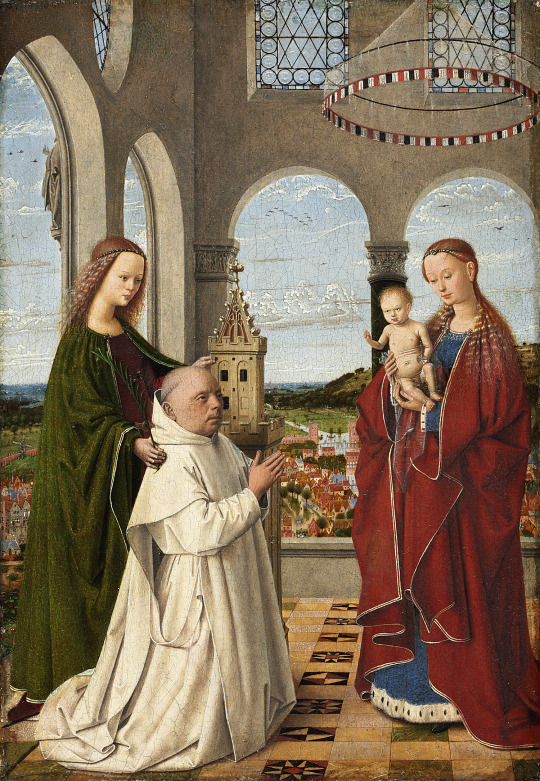
Petrus Christus - Madonna and Child with Saint Barbara and Carthusian Monk. 1450
113 notes
·
View notes
Text
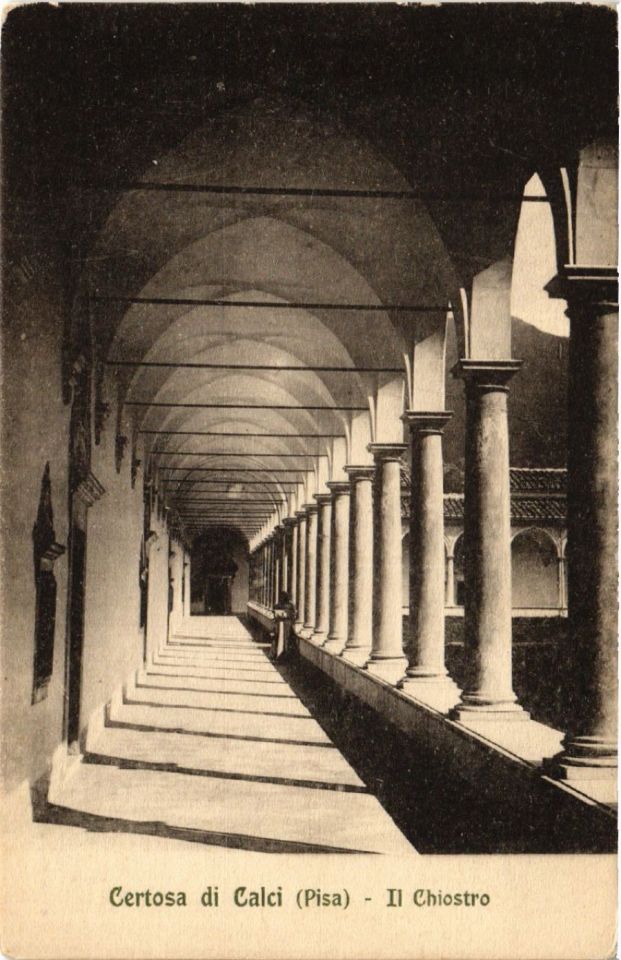
Cloister of the Certosa di Calci Carthusian monastery in Pisa, Tuscany region of Italy
Italian vintage postcard
#vintage#calci#tarjeta#italy#old#briefkaart#postcard#photography#region#postal#carte postale#sepia#di#carthusian#monastery#ephemera#cloister#historic#ansichtskarte#italian#certosa#postkarte#pisa#calci carthusian#tuscany#postkaart#photo
4 notes
·
View notes
Text

Carthusian nun in her garden working on ecclesiastic embroidery.
12 notes
·
View notes
Text
Research trip to Mount Grace Priory

An old interest in monks has resurfaced. I studied Carthusians once upon a time (their manuscripts, really). The interest flares up now and again. This meant that a visit I'd long put off was back on the cards. Drove down to Northallerton in North Yorkshire on Sunday to see the ruin of Mount Grace Priory.
Mountgrace was founded in 1398 by Thomas de Holand, a nephew of Richard II. Carthusians and their brand of piety was super-fashionable at the time (due to the strictness of their Rule and a general post-Black Death rethink) but having a founder connected to Richard II became a problem. In 1415, it was re-founded by Thomas Beaufort. Mountgrace only lasted until 1539, when the Suppression of the monasteries kicked in.
I was keen to look at the reconstructed monk's cell.
I took lots of photos.
Lots.
Here's a few.
View of the church and bell tower

Entering the monk's cell

Laybrothers cooked the food, were responsible for upkeep and general day-to-day activities under the watch of the Procurator. (Laybrothering was a prestigious position. A few bishops retired to take up the job.) Among lots of other jobs, they would deliver food into hatches like this so the monks wouldn't have to interact.

Straight ahead is the living quarters. The fireplace in this cell is smaller than the one found in the sacrist's cell.

Desk by the windows. Lots of natural light.

A place to rest yourself and your reading materials

A place to rest yourself (the Carthusian schedule is brutal).

If you turn left, there's a nice glazed, private cloister looking out onto the cell garden.

If you turn right at the entrance, a covered walkway leads to the garden, freshwater drinking pipe and latrine (both plumbed in. Monastery plumbing was something else. I've seen the plans for London Charterhouse).

More garden! Small fruit tree and exterior view of the glazed private cloister.

Exterior view of the cell from the garden.

Let's go back inside and go upstairs! (These stairs really are steep. Believe the sign next to the fireplace. You have to come down backwards.)

Upstairs, we find the workshop! Spinning, weaving, copying books, woodwork, lots of useful activity.

Once that bell rings, you've got to go to church. A huge covered cloister once connected all those doorways and led to the church.
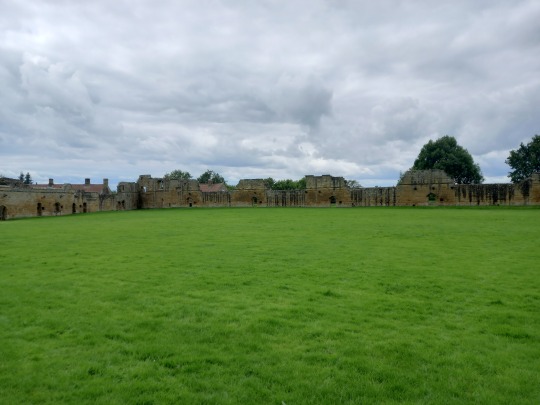
Can't remember if this is the church or chapter house I'm standing in.

Would've been a lovely window here, I bet.
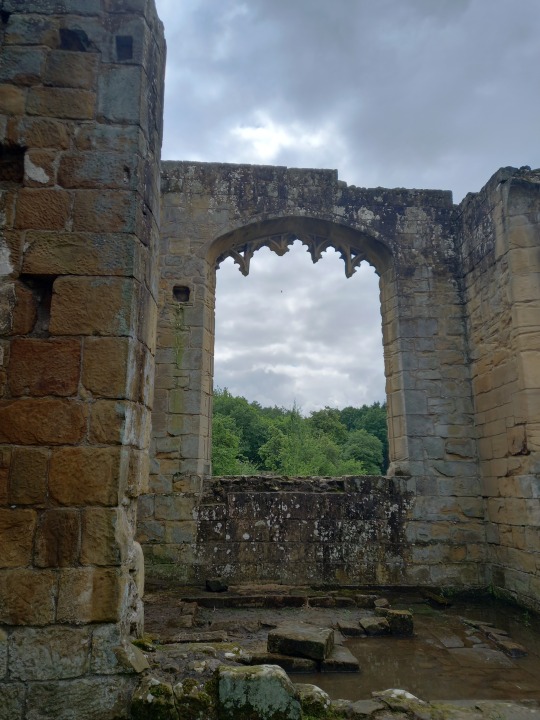
The guest house was in better condition, mainly because Sir Lowthian Bell decided to restore it (and reconstruct the monk's cell). Here it is from the gardens.

There's still some original red plasterwork from the 14th century.

There's a decent museum in the guest house too. If you're into the Arts and Crafts movement, there's some Morris and Co. wallpaper and furniture, plus a couple of restored rooms. I liked this 14th century stone window looking into an Arts and Crafts lounge.

A pretty good day's research! Definitely recommend the place. Absolutely worth the trip.
#research#carthusians#mount grace priory#mountgrace charterhouse#carthusian#14th century#ruins#old ruins#late medieval#monks#arts and crafts#history#reformation#dissolution of the monasteries#charterhouse
6 notes
·
View notes
Text
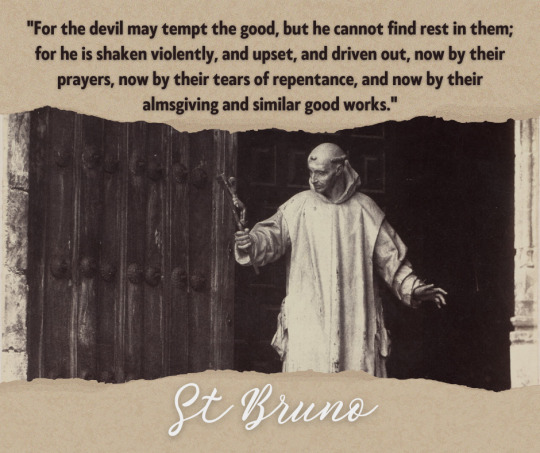
St. Bruno of Cologne, " For the devil may tempt the good, but he cannot find rest in them; for he is shaken violently, and upset, and driven out, now by their prayers, now by their tears of repentance, and now by their almsgiving and similar good works."
#St. Bruno#saint bruno#st. bruno of cologne#catholic saint quotes#catholic#catholic saints#catholicism#christian quotes#tradcath#saints#god#jesus christ#trad catholic#bruno of cologne#carthusian#catholic church#roman catholicism#catholic tumblr#catholic tradition#catholic things#catholic theology#catholic tag#saint quotes#saint quote#feast day#ora pro nobis#oremus
16 notes
·
View notes
Photo


Free Cat Wallpapers on my ko-fi! ko-fi.com/yfty/shop
#free wallpaper#cat wallpaper#pink aesthetic#heart#cute#cute cat#calico#tortoiseshell#artist on kofi#artist support#artists on tumblr#cat art#carthusian#chartreux#grey tabby#brown tabby#orange cat#siamese cat#white cat#black and white cat#cute wallpaper#phone wallpaper
6 notes
·
View notes
Text
youtube
This documentary about an austere, contemplative Catholic monastic order, the Carthusians, in Korea is well worth watching. It is observational and without commentary, rather like a previous classic documentary, Into Great Silence, about Carthusians in France.
0 notes
Link
Why were and are there so many different types of monks? What’s the difference between Benedictines, Cistercians, Carthusians, Norbertines, Augustinians, and other monks? Why were monks “Spiritual Warriors”? Discover here why there were so many different types of monks in the Middle Ages and the main medieval orders, and also the chief differences between these different monastic orders, at least in the Middle Ages.
#Monks#Medieval#Middle Ages#Benedictine#Cistercian#Carthusian#Norbertine#Premonstratensian#Augustinian#Austin Canon#Spiritual Warriors#Monastery#Abbey
1 note
·
View note
Photo

It was so nice to step out today on lunch break to pop back to the old school @charterhousesch to pick up a piece of the historic stained glass which used to be in the old chapel. It was also lovely to catch up with Catherine from Archives as I did work with her and the Charterhouse foundation a while back. I also got a whistle stop tour of all the new changes at the school, including the new and refurbished OHH Reception and Brooke Hall. It was also wonderful to get recognised by a few staff members who had known me throughout my time, including a lovely security guard who remembered me for playing the organ and the bells and the admissions lady who saw me join as a 13 year old and saw me finish as a 18 year old😊💜. The windows were made in 1874 & 1878 and they were removed in 1940 when the chapel got converted into what we know as the Old Music School. The glass has also survived two fires whilst in storage. Thank you Catherine for the lovely tour. Every time I come back and see the changes, it never stops me feeling like I’m back home again 😊💜. #Charterhouse #OldBoy #Alumni #OldCarthusian #OC #ProudtoBeAnOC #Home #5Years #Carthusian #DeoDanteDedi #OldSchool #Surrey #SurreyLife #Godalming #Countryside (at Charterhouse School) https://www.instagram.com/p/CkjO9S-Kcta/?igshid=NGJjMDIxMWI=
#charterhouse#oldboy#alumni#oldcarthusian#oc#proudtobeanoc#home#5years#carthusian#deodantededi#oldschool#surrey#surreylife#godalming#countryside
0 notes
Text
While we await the results of St Mary Magdalene vs. St Dymphna, here's another poll for all of you!
Here are some resources to learn more about each of them:
Religious orders in pictures
Most well known religious orders
A video on religious orders
#cistercians#redemptorists#jesuits#salesians#dominicans#franciscans#missionaries of charity#benedictines#carmelites#carthusians#catholic saint tournament#catholic#catholicism#catholic saints#christianity#polls#theology#tumblr polls
64 notes
·
View notes
Text

Entrance gate of the Carthusian Monastery of Valbonne, Languedoc region of southern France
French vintage postcard
#historic#photo#briefkaart#vintage#region#the carthusian monastery of valbonne#gate#monastery#southern#entrance#sepia#languedoc#photography#carte postale#postcard#postkarte#france#postal#tarjeta#carthusian#ansichtskarte#french#old#ephemera#postkaart#valbonne
5 notes
·
View notes
Text
[Edward IV] was directly responsible for the introduction into England of the admired continental order of Observant Franciscans. The moving spirit in this venture was probably his sister, Duchess Margaret of Burgundy, who had strong connections with the Order, and who spent much time at Greenwich during her visit to England between July and September 1480: she may well have felt that her brother’s soul stood in need of prayer."
-Charles Ross, "Edward IV" (italics by me)
introducing a new religious continental order to England not because you actually give a fuck about it but because your younger sister pressured you to do it is SO on brand <3
#edward iv#he and EW being granted license to hear services within the Carthusian house at Sheen was almost definitely at EW's instigation as well#since she had gained permission to enter Carthusian houses and hear masses there just 2 years earlier#my post#queue#margaret of york duchess of burgundy
3 notes
·
View notes
Photo

Saint Bruno of Cologne
1030-1101
Feast Day: October 6
Patronage: Germany, Carthusians, Calabria, monastic fraternities, trademarks, help for possessed people
Saint Bruno was the founder of the Carthusians, (by retiring to a hermitage with 6 companions in 1084). They are noted for their strict tradition and the austere rule of St. Benedict’s contemplative life. He was born to a prominent family, taught for 25 years in Reims, appointed Chancellor of the archdiocese at 45 and supported Pope Gregory VII and Pope Urban II in the fight against decadent clergy, even helping remove his own scandalous archbishop. He died giving a profession of faith to the Catholic Church’s Sacraments especially the True Presence.
{website}
64 notes
·
View notes
Photo

Carthusian Monks | Chartreuse | Bert Hardy | Getty | WSJ
29 notes
·
View notes
Text

St Bruno of Cologne
In honor of St Bruno of Colognes feast day (Oct. 6), my design includes photos of La Grande Chartreuse. St. Bruno founded the Carthusian order and built this original monastary in 1084. It was repeatedly rebuilt, and renovated. In the 1900's, it was rented from the state. However, with the Association Laws of 1901, the monks were expelled by squadrons on April 19th 1903. The bottom photo is of actual expelled monks. Referencing, "While the world changes, the cross stands firm."
#St. Bruno of Cologne#St. Bruno#Bruno of Cologne#Le Grande Chartreuse#monks#catholic monks#catholicism#christian quotes#catholic saints#tradcath#saints#god#jesus christ#catholic#trad catholic#catholic saint quotes#history#cultures#carthusian#oremus#ora pro nobis#Laws#persecuted church#god fearing people living in tight communities started persecuting marginalized women. and the crusades#persecuted christians#persecución#persecuzioni
2 notes
·
View notes
Text
SAINT OF THE DAY (October 6)

On October 6, the Catholic Church commemorates Saint Bruno of Cologne, founder of the Carthusian order of monks who remain notable for their strictly traditional and austere rule of contemplative life.
Born in 1030, Bruno is said to have belonged to a prominent family in the city of Cologne.
Little is known of his early years, except that he studied theology in the present-day French city of Reims before returning to his native land, where he was most likely ordained a priest in approximately 1055.
Returning to Reims the following year, he soon became head of the school he had attended there, after its director Heriman left to enter consecrated religious life in 1057.
Bruno led and taught at the school for nearly two decades, acquiring an excellent reputation as a philosopher and theologian, until he was named chancellor of the local diocese in 1075.
Bruno's time as chancellor coincided with an uproar in Reims over the behavior of its new bishop Manasses de Gournai.
Suspended by the decision of a local council, the bishop appealed to Rome while attacking and robbing the houses of his opponents.
Bruno left the diocese during this period, though he was considered as a possible successor to Manasses after the bishop's final deposition in 1080.
The chancellor, however, was not interested in leading the Church of Reims.
Bruno and two of his friends had resolved to renounce their worldly goods and positions and enter religious life.
Inspired by a dream to seek guidance from the bishop later canonized as Saint Hugh of Grenoble, Bruno settled in the Chartreuse Mountains in 1084, joined by a small group of scholars looking to become monks.
In 1088, one of Bruno's former students was elected as Pope Urban II.
Six years into his life as an alpine monk, Bruno was called to leave his remote monastery to assist the Pope in his struggle against a rival papal claimant as well as the hostile Holy Roman Emperor Henry IV.
Bruno served as a close adviser to the Pope during a critical period of reform.
Around this time, he also rejected another chance to become a bishop, this time in the Italian region of Calabria.
While he obtained the Pope's permission to return to monastic life, Bruno was required to remain in Italy to help the Pope periodically, rather than returning to his monastery in France.
During the 1090s, Bruno befriended Count Roger of Sicily and Calabria, who granted land to his group of monks and enabled the founding of a major monastery in 1095.
The monks were known, then as now, for their strict practice of asceticism, poverty, and prayer; and for their unique organizational form, combining the solitary life of hermits with the collective life of more conventional monks.
St. Bruno died on 6 October 1101, after making a notable profession of faith which was preserved for posterity.
In this final testimony, he gave particular emphasis to the doctrine of Christ's Eucharistic presence, which had already begun to be questioned in parts of the Western Church.
“I believe,” he attested, “in the sacraments that the Church believes and holds in reverence, and especially that what has been consecrated on the altar is the true Flesh and the true Blood of our Lord Jesus Christ, which we receive for the forgiveness of our sins and in the hope of eternal salvation.”
Veneration of St. Bruno was given formal approval in 1514 and extended throughout the Latin Rite in 1623.
More recently, his Carthusian Order was the subject of the 2006 documentary film “Into Great Silence,” chronicling the life of monks in the Grand Chartreuse monastery.
9 notes
·
View notes